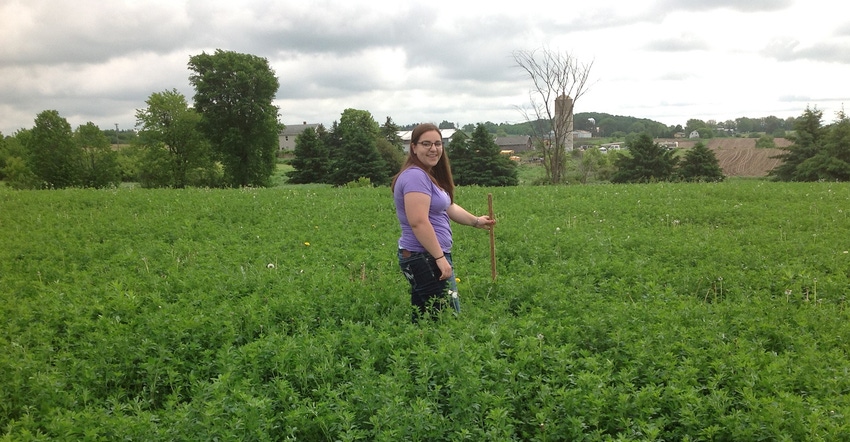March 9, 2022

How can you determine when to harvest the first cutting of forages in Wisconsin? Many farm managers will want to go by a calendar date; however, if you look at 10 years of data from my former colleague Mike Rankin, that date could range from prior to May 20 to after June 1, depending on weather conditions and the type of forage in the field.
First, the livestock you are feeding will determine the forage quality you need to harvest. If a dairy farm needs 170 relative feed value coming out of storage, then harvest standing forage at 190 RFV.
Second, what type of forage do you have in the field? A grass stand will start growing sooner in spring and will begin to mature based on day length, not growing degree days, while GDD will drive maturity of alfalfa when the stand is a mix of grass and alfalfa. A clover stand is yet another consideration.
When to harvest forages
We need to “build a better mousetrap” to determine when to harvest forages. Two methods:
1. Scissor clipping. This method works best for grass and alfalfa mixed stands (legume and grass). The key for scissor clipping is to clip the sample at about the same height as you would harvest with your mower to be accurate. Collect the sample in a plastic bag, remove the oxygen, and take it directly to the lab. A cost will be involved for the lab analysis.
2. Predictive Equations for Alfalfa Quality. This will only work if alfalfa is present in a stand. You could purchase a PEAQ stick from your local forage association council or contact the Midwest Forage Association. Understand a PEAQ stick will only determine RFV of alfalfa. The ease of it is once you purchase the PEAQ stick, you will have no cost.
PEAQ stick measurements are as accurate as scissor-clipping results as the crop matures. But remember, you are determining RFV, not relative feed quality (RFQ), which is a different calculation used to determine feed quality. RFV is accurate to determine when to harvest first-cutting alfalfa.
A PEAQ stick has four sides: one side is a measuring stick; the other three identify alfalfa stage of growth — vegetative, bud and bloom. Begin early in the season using the vegetative side. As buds become present, turn a quarter turn and measure height. If a bloom is present, turn another quarter turn and measure plant height.
A PEAQ stick is accurate to aid you as a manager to harvest your forage to attain the quality you desire. Remember, harvesting and storage of mismanaged forage may not yield the result you desire, even when harvesting at the correct maturity.
As mentioned, you will need to begin harvest about 20 points above your desired forage RFV. If you have a mixed stand of alfalfa-grass-clover, measure the alfalfa to determine the stage of growth and current RFV estimate. If the grass has a seed head beginning to move upward in the sheath, you may want to cut sooner than later.
Another method to keep you informed of forage quality changes during the spring is to visit this University of Wisconsin-Extension site. A number of Extension agriculture educators are collecting data and posting it on this site each week during the spring season. In addition, many will have reports on local radio stations or websites with forage changes each week.
In summary
To summarize, using a calendar date to cut first-crop forage may not be the best method, as there is no correlation between calendar date and RFV of forages. Scissor clipping is a good method, though it involves more work and some cost each time you check a sample. But it may be the best method for grass or mixed forage stands. The PEAQ stick will provide a low-cost investment alternative to determine harvest timing for alfalfa, or you could follow the UW-Extension site for the changes of forage quality each spring.
First cutting of forage will supply about 50% of your forage needs for the year, and you know that in the dairy business you need quality forage. If you have questions on PEAQ or scissor clipping, please contact your county Extension agriculture educator or myself at [email protected].
Halopka is a certified crop consultant and is a senior outreach Extension crops and soils specialist in Clark County, Wis.
You May Also Like




